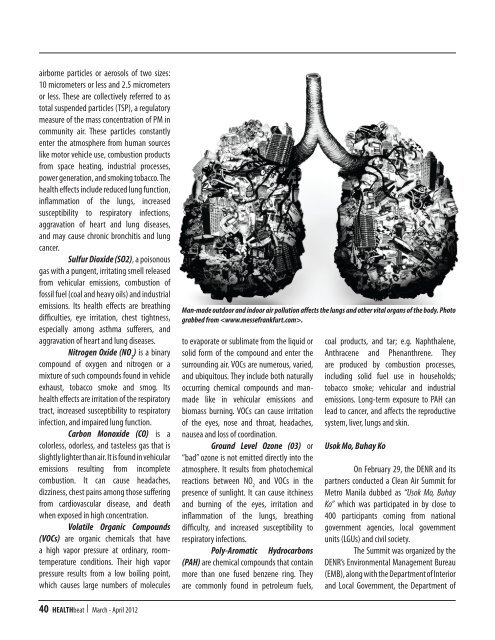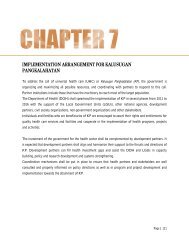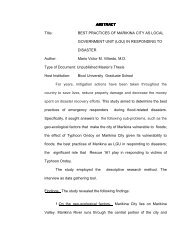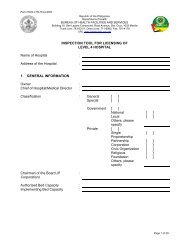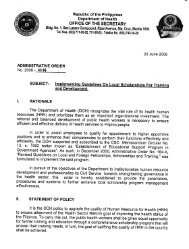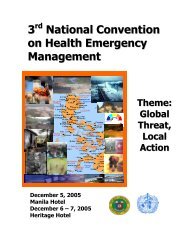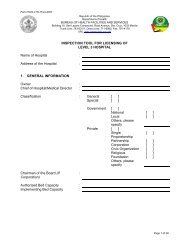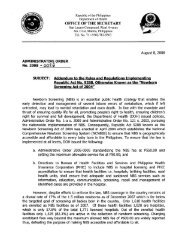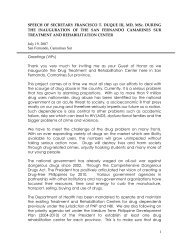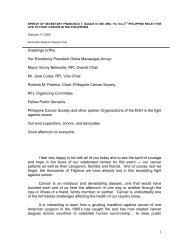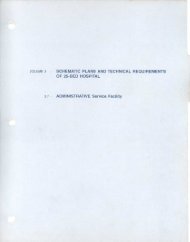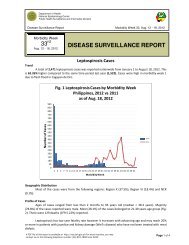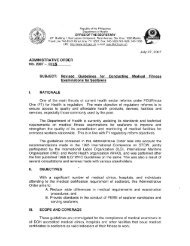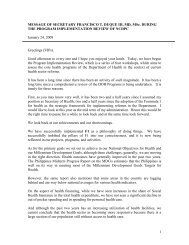airborne particles or aerosols of two sizes:10 micrometers or less and 2.5 micrometersor less. These are collectively referred to astotal suspended particles (TSP), a regulatorymeasure of the mass concentration of PM incommunity air. These particles constantlyenter the atmosphere from human sourceslike motor vehicle use, combustion productsfrom space heating, industrial processes,power generation, and smoking tobacco. Thehealth effects include reduced lung function,inflammation of the lungs, increasedsusceptibility to respiratory infections,aggravation of heart and lung diseases,and may cause chronic bronchitis and lungcancer.Sulfur Dioxide (SO2), a poisonousgas with a pungent, irritating smell releasedfrom vehicular emissions, combustion offossil fuel (coal and heavy oils) and industrialemissions. Its health effects are breathingdifficulties, eye irritation, chest tightness,especially among asthma sufferers, andaggravation of heart and lung diseases.Nitrogen Oxide (NO 2) is a binarycompound of oxygen and nitrogen or amixture of such compounds found in vehicleexhaust, tobacco smoke and smog. Itshealth effects are irritation of the respiratorytract, increased susceptibility to respiratoryinfection, and impaired lung function.Carbon Monoxide (CO) is acolorless, odorless, and tasteless gas that isslightly lighter than air. It is found in vehicularemissions resulting from incompletecombustion. It can cause headaches,dizziness, chest pains among those sufferingfrom cardiovascular disease, and deathwhen exposed in high concentration.Volatile Organic Compounds(VOCs) are organic chemicals that havea high vapor pressure at ordinary, roomtemperatureconditions. Their high vaporpressure results from a low boiling point,which causes large numbers of moleculesMan-made outdoor and indoor air pollution affects the lungs and other vital organs of the body. Photograbbed from .to evaporate or sublimate from the liquid orsolid form of the compound and enter thesurrounding air. VOCs are numerous, varied,and ubiquitous. They include both naturallyoccurring chemical compounds and manmadelike in vehicular emissions andbiomass burning. VOCs can cause irritationof the eyes, nose and throat, headaches,nausea and loss of coordination.Ground Level Ozone (03) or“bad” ozone is not emitted directly into theatmosphere. It results from photochemicalreactions between NO 2and VOCs in thepresence of sunlight. It can cause itchinessand burning of the eyes, irritation andinflammation of the lungs, breathingdifficulty, and increased susceptibility torespiratory infections.Poly-Aromatic Hydrocarbons(PAH) are chemical compounds that containmore than one fused benzene ring. Theyare commonly found in petroleum fuels,coal products, and tar; e.g. Naphthalene,Anthracene and Phenanthrene. Theyare produced by combustion processes,including solid fuel use in households;tobacco smoke; vehicular and industrialemissions. Long-term exposure to PAH canlead to cancer, and affects the reproductivesystem, liver, lungs and skin.Usok Mo, Buhay KoOn February 29, the DENR and itspartners conducted a Clean Air Summit forMetro Manila dubbed as “Usok Mo, BuhayKo” which was participated in by close to400 participants coming from nationalgovernment agencies, local governmentunits (LGUs) and civil society.The Summit was organized by theDENR’s Environmental Management Bureau(EMB), along with the Department of Interiorand Local Government, the Department of40 HEALTHbeat I <strong>March</strong> - <strong>April</strong> <strong>2012</strong>
Transportation and Communication (DOTC),the Metro Manila Development Authority(MMDA), the Kapisanan ng mga Brodkasterng Pilipinas (KBP) and the Philippine MedicalAssociation (PMA). Late last year, the DENR,PMA and KBP signed a Memorandum ofAgreement that sought to strengthen theanti-smoke belching program in MetroManila in an effort to maintain reducedparticulates in Metro Manila. PMA and KBPcommitted to help raise public awarenesson the urgency of addressing the country’sworsening air pollution problem.The Summit drew attention to theunhealthy effects of constant exposure toair pollution especially in Metro Manila, andenjoined commitments from various sectorsto address the problem. It was agreed uponduring the summit that there was need for a“no nonsense crackdown plus a readjustmenton policies involving the implementation” ofthe Clean Air Act.Under the Clean Air Act, theDENR has a major role as it serves as theenvironmental pollution regulatory agencyparticularly for air quality by settingstandards, enforcement and monitoring.The <strong>DOH</strong>, on the other hand, has therole of participating in the developmentof air quality policies, guidelines andstandards. The <strong>DOH</strong> also provides healthinformation relative to diseases related toair pollution. The Department of Energysets specifications for all fuel types andfuel-related products. Meanwhile, the DOTCthrough the Land Transportation Office(LTO) conducts roadside inspection andemission tests for approval and renewal ofvehicle registrations. The LGUs includingMMDA and as deputized by the LTO alsoconduct roadside inspections and emissiontest for smoke belching vehicles. They arealso mandated to implement the banningof smoking in public places and burning ofwastes.Dr. Mike Aragon, PMA media affairschairman, said laws and policies governingair pollution need amendments to makethem attuned to the times. “Enforcementis the problem. Unsustained enforcementof the law coupled with graft is a majorstumbling block in eliminating air pollutionin the National Capital Region,“ he said.Dr. Mardave Martinez, PMA vicepresident, said air pollution “kills” and itshould not be tolerated. Before death comes,an affected family will first suffer from hugehospital expenses and loss of income due tosickness related to air pollutants, he said.Meanwhile, Health SecretaryEnrique T. Ona said that having a systematicand strict implementation on programs andinitiatives to reduce air pollution would havedirect health significance. As the presentadministration seeks towards achievingKalusugan Pangkalahatan (UniversalHealth Care), strengthening the promotionand monitoring for air quality is indeed animportant health issue to address. As everyFilipino deserves access to quality healthcare services, everyone also deserves a goodfresh air to breathe in especially here inMetro Manila.Measuring Air QualityA month after the Summit, theDENR reported that it has started puttingair quality monitoring stations capableof gathering PM 10and PM 2.5. The TSP willstill be monitored, but Sec. Paje said, “Wedo recognize the importance of shiftingto measuring PM 10PM 2.5as the moreappropriate indicators of the adverseimpacts of air pollution on human health.”He stressed that with the levels ofTSP going down, the DENR can now focusmore in coming up with concrete measuresto address PM 10and PM 2.5pollution. Based onthe DENR National Air Quality Status Report2005-2007, the TSPs were on a decreasingtrend – from 144 to 97 microgram per<strong>No</strong>rmal cubic meter (ug/Ncm) but theconcentrations are still above the annualmean for TSP guideline value for one year of90 ug/Ncm.The DENR has already set upPM 10monitoring stations in Metro Manila.There are nine stations monitoring PM 10,6 of which are manual and are situated inCaloocan, <strong>DOH</strong> Manila, MRT Pasay-Taft,Marikina, National Printing Office (NPO)-EDSA and MMDA Guadalupe. There are threeautomatic stations and these are located atRadyo ng Bayan in Valenzuela City, AteneoUniversity and National Mapping andResource Information Authority (NAMRIA)which also measures PM 2.5.Based on EMB records, moststations showed readings that exceed thePM 10annual guideline value of 60 microgramper normal cubic meter as provided for inthe Clean Air Act. These are the stations atNPO-EDSA (74 ug/Ncm), Marikina (66 ug/Ncm), Pasay-Taft (130 ug/Ncm), Valenzuela-Radyo ng Bayan (64 ug/Ncm) and Caloocan-Partisol (168 ug/Ncm).Paje added that the installation ofadditional monitoring stations on PM 10andPM 2.5is now underway. For <strong>2012</strong>, the DENRwill put seven more PM 10and PM 2.5stations,and eventually work towards setting upstations in all cities and municipality ofMetro Manila in 2013.Paje stressed the need for moreintervention to achieve healthy air quality.This includes the enhancement of antismokebelching operations in Metro Manila;the adoption of more stringent emissionstandards for all types of motor vehicles;and stricter monitoring of private emissiontesting centers and motor vehicle inspectionstations with the use of closed-circuittelevision or CCTV cameras.- o O o -<strong>March</strong> - <strong>April</strong> <strong>2012</strong> I HEALTHbeat 41


